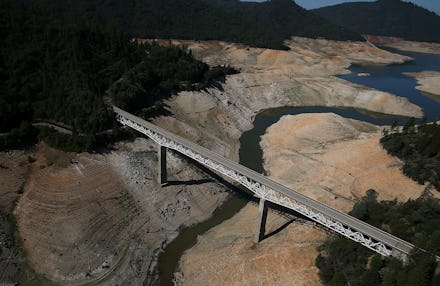New Study Reveals California's Drought Crisis Is the Worst It's Been in Over a Millennium

California's ongoing, three-year drought is widely considered among the most disastrous droughts in American history. But new research has suggested that we actually haven't seen anything like this in documented history.
Climate scientists Daniel Griffin from the University of Minnesota and Kevin Anchukaitis of the Woods Hole Oceanographic Institution have collected new tree ring samples that led them to conclude that California's drought is the worst in at least 1,200 years.
Yes, 1,200 years.
Samples from blue oak trees allowed them to reconstruct rainfall levels back to the 13th century, and when they combined that information with National Oceanic and Atmosphere Administration and North American Drought Atlas records, it became clear that California hasn't experienced anything like this in more than a millennium.
According to ScienceDaily, "while the current period of low precipitation is not unusual in California's history, these rainfall deficits combined with sustained record high temperatures created the current multiyear severe water shortages." Basically, while the low rainfall levels aren't unprecedented, low rainfall levels combined with such persistently high temperatures are rare enough that the current drought is a total anomaly.
Did someone say global warming?
While the researchers were careful to note that California's history is littered with long, severe "megadroughts," ScienceDaily notes that the "current short-term drought appears to be worse than any previous span of consecutive years of drought without reprieve."
The scientists suspect that this is evidence that the drought is likely closely related to human-induced climate change. Anchukaitis told ScienceDaily that "... there is no doubt that we are entering a new era where human-wrought changes to the climate system will become important for determining the severity of droughts and their consequences for coupled human and natural systems."
He might be speaking up too late. Many of California's reservoirs have been totally drained and now look like this:
According to the U.S. Drought Monitor, an astonishing 55% of the state remains in category D4, "exceptional drought," and 80% remains in "extreme drought." Almost every single inch of California remains at "severe drought" or more.
Even worse, 1,200 years ago is just the farthest back that the researchers can accurately study with available methods. It's possible that the last time California saw a drought like this was much farther back.
Scientists have been warning for years that extreme weather patterns like the one that is causing the ongoing drought will only become more common as climate change progresses. The ongoing drought, which was projected in July to cause losses of around $2.2 billion, is an ongoing demonstration that climate change is already a force in the here and now that needs to be confronted immediately.
There's room for both optimism and pessimism. A Munich Re America survey released earlier this week concluded that 83% of Americans now believe in climate change, but found that just 14% cared more about it than threats like political instability, economic crises and pandemics. It will take some time to convince Americans that preparing for climate change needs to be a higher national priority. In the meantime, California is still dying of thirst.